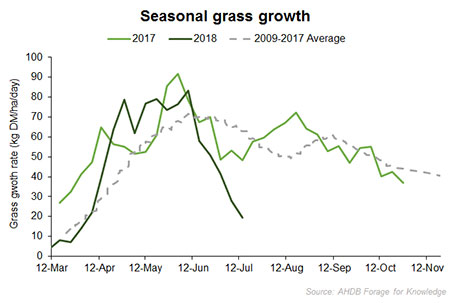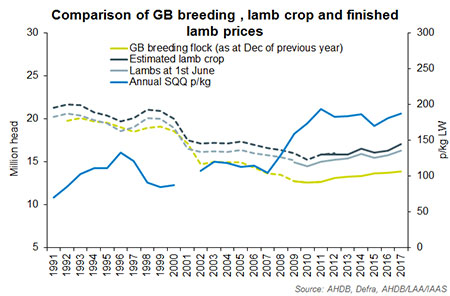Mixed weather of 2018 - the impact on the national breeding flock
Wednesday, 15 August 2018
This year the weather has reached highs and lows, both in terms of temperature and rainfall. Winter was cold and wet, the summer has been hot and dry. The number of days with ground frost increased significantly year-on-year during February and March. In contrast, during June the mean temperature was on average higher on the year, with significantly less rainfall. The poor conditions during lambing caused an increase in ewe and lamb mortality. Not only will this lead to a smaller lamb crop despite an estimated increase in the breeding flock, but also the number of ewes available to put back to the ram in the autumn is also likely to be reduced. Click here to read the latest outlook for lamb slaughterings.

Looking at the size of the GB breeding flock at December 1995 (perhaps the most comparable year for weather), it was 2%, or 426,200 head smaller than at December 1994, according to Defra data. The breeding flock then recorded another year of decline in 1996, before recording two years of growth back to December 1994 levels. After that, various factors including lower farmgate prices, followed by the FMD outbreak, and then the removal of headage payments, influenced the national flock to contract.
With many breeding flocks smaller than expected after lambing this year, there are now several paths that farmers may take. For example, keeping older ewes on for another year, keeping more lambs back for future breeding, or contracting the flock. All will have some negative effect on production either this year or beyond, and are discussed below.

Keeping older ewes on for another year could have implications for the lamb rear rate next year. Scanning numbers may be higher in older ewes, as long as body condition is good, but there is an increased risk of ewe mortality. They may have teeth problems so maintaining body condition may be challenging, plus there is an increased risk of udder problems, which would affect lamb growth rates. This could affect mutton production this year, and have an impact on the number of available lambs for slaughter next year.
Additional lambs may be retained for home-bred replacements or to sell on. This would negatively affect lamb production this year as more ewe lambs are retained, and production next year could be affected if the age profile of the national flock declined significantly, as scanning results may be affected. However, the poor availability of grass and forage this autumn may reduce the numbers retained, or the number that will be bred as ewe lambs, as weight targets may not be reached.
The high prices in early 2018 also encouraged farmers to sell lambs that were being retained as potential breeders, so the likely lower prices for replacements this year may encourage a greater retention.
Finally, the flock may contract. This would be achieved through a combination of decisions and actions. Producers may simply retain or buy in only the usual number of replacements typically needed to replace culled ewes, but decide not to replace those lost in the spring. Equally, for example for cash flow reasons, producers may decide to retain or buy-in fewer replacements than they may have originally planned. This could be due to having a smaller lamb crop and needing to maintain cash flow. Overall, the effect would mean this year’s production, while still below previous years, would be supported even with fewer lambs on the ground. However the size of the 2019 lamb crop would be reduced even if lamb rear rates recovered, due to the smaller breeding flock.

As well as current cash flow, another reason to contract the size of any one breeding flock this year may be winter forage supplies. As is well documented, grass growth has been poor, slow to start and then slow again from early July. The lack of grass growth has already impacted lamb production and sheep meat exports.
Click here to read the AHDB report Agricultural drought impact: Summer 2018.
Analysis into the link between feed usage for sheep and weather can be found here.
So there are several options for sheep farmers, and most likely the uptake of each will vary. The best (or least bad) option for one farmer will be different for another. When making the decision where to take a breeding flock in the coming year, some farmers will be attempting to consider the impact on production both this year and in the future, and the inevitable effect this will have on cash flows.

